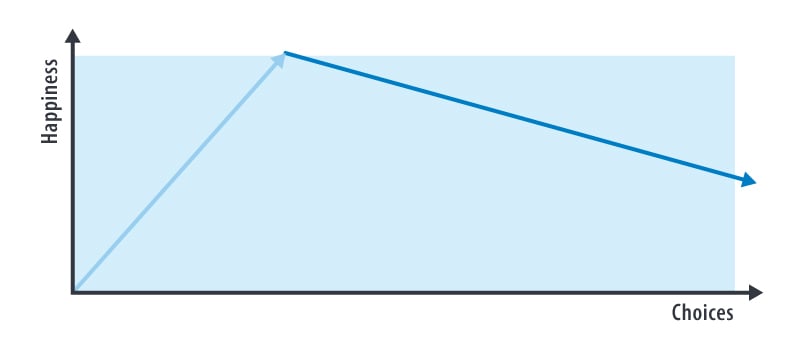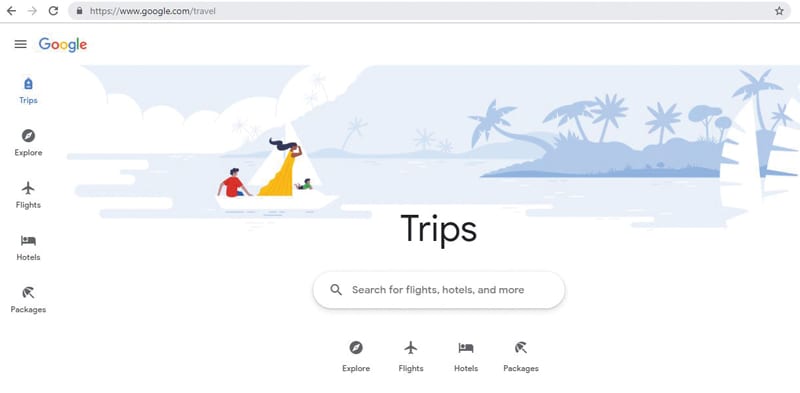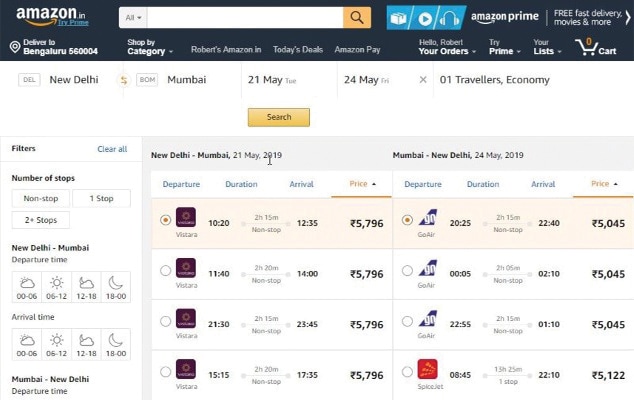Whether you call it the elephant in the room or the 500-pound gorilla, Google and Amazon are both looking at the travel industry as a new source of revenue. They’re threatening to disrupt the travel market in two different ways. In 2016, Google jumped into travel with its Trips app. Amazon took off on a smaller scale in May 2019 by enabling the payment of domestic flight tickets in India through Amazon Pay.1 Both companies know a lot about their customers, and that data is a gold mine.
Their mastery of data will enable them to introduce the next wave of travel industry disruption. They can predict when customers are planning a vacation and where they want to go. Their new Netflix-style approach makes it easier for consumers to plan, book and be more spontaneous about travel. This is the future of disruption in the travel industry.
Digital travel’s paradox
The last wave of disruption in the travel industry started with websites like Booking.com, Skyscanner, Kayak and TripAdvisor. Travel websites effectively became travel agents and revolutionized the way people plan and book their holidays. TripAdvisor went about this in the most unexpected way. The website started off as a place for people to review hotels and restaurants. It then went on to become a great way to plan where to go on vacation and what to do while you’re there.
While the digital revolution democratized choice for the travel industry, it made decisions more difficult. The problem is that consumers now have so many destinations right at their fingertips. Psychologist Barry Schwartz coined the phrase “Paradox of Choice” (Figure 1). He found that while increased choice allows us to achieve objectively better results, it also leads to greater anxiety, indecision, paralysis and dissatisfaction.
To improve this situation, Google’s travel solution takes some inspiration from what Netflix created for TV. You can watch thousands of movies and TV shows on Netflix, and Google has at least that many trips you can book. Netflix does a lot of work behind the scenes to help you make up your mind. The Netflix algorithm suggests content you might be interested in based on user data. Google is doing the same thing, using an algorithm to determine where you want to take a trip and what you might want to do while you’re there.
Perhaps, the most important card up Google’s sleeve is not its design, but its Google Reviews
Google has recently increased its review volume and made Google ratings more prominent in its search, maps and hotel listings. That’s where it really starts to edge in on TripAdvisor’s space.
Online reviews left by strangers have become almost as trusted as personal recommendations. However, placing this much trust in reviews requires the user to be able to filter real reviews from fake ones. This can be hard to do, but at least fake reviewers are starting to face some real consequences. In September 2018, a man in Italy was sentenced to nine months in jail for selling fraudulent TripAdvisor reviews. In December 2018, Google was hit with a massive fake review attack. The company confirmed 37 fake profiles posted over 3 million fake 4-star ratings. Google removed all the fake reviews about five days later. There’s no word who initiated this attack, but it highlights the issue of automated or systematic review spam.
Figure 1. Paradox of Choice: Less is more because too much choice is stressful

Source: Barry Schwartz
Google: The elephant in the room
Now, Google is bringing its nice, clean look and search engine strength to the game. What does that mean for travelers? Google is the organization with the most data. They want to help you keep your trip planning organized, learn about you and advertise to you at the same time. In May, Google unveiled a streamlined trip-planning platform called Google Travel (Figure 2). It brings Google Flights, Google Hotels and other tools under one roof, making it easier to plan your travel itinerary. This combines the advantages of the mobile Google Trips app, Google Flights, and Google Hotels and its search functionality. It’s a streamlined experience that you can access from any device and pick up where you left off. You can access all booking information within your itinerary, including confirmation codes and travel information as well as weather forecasts for your travel time. This launch is the beginning of an evolution for Google’s travel services.
If you’re signed in to your Google account, your recent searches, saved places and flights are automatically added to your travel account. Google adds items you viewed and saved, including hotels, to your trips so you don’t have to reinvent the wheel or keep track of all the details yourself. Basically, Google becomes your travel wallet.
The information keeps coming from Google once you reach your destination. Google Maps does more than just point out places to see, restaurants to try and things to do. It will now pinpoint popular neighborhoods nearby and what they may be famous for. Google wants its Maps to be the ultimate go-to for all information while you travel.
Google also creates a digital footprint that allows travelers to relive their vacation.
It tracks every moment using Google location tracking. This lets travelers look back and see where each picture was taken, restaurants where they ate and even where they went sightseeing. Location tracking can also be used for push advertising. Google knows you’re traveling with children and that it’s hot. That information lets Google make a prediction and recommend a nearby gelato shop on a hot afternoon. This is a new channel for Google’s clients to reach their customers, further extending the search giant’s reach as the advertiser of choice online. For the end consumer, it really could take the travel experience to a whole new level.
The sharing of data across all Google products results in an extremely personalized Google Travel experience that some people will find helpful and others will find intrusive.
What if you don’t want Google tracking your entire thought process as you plan? You can opt out by changing your settings, but by doing so you also stand to lose the cross-platform functionality.
Some say Google has an unfair advantage. As the world’s largest search engine, Google is the de facto gatekeeper for online travel planning. When you search for a flight or a hotel, Google controls what appears at the top of the results. It’s no surprise that Google’s own platform is at the top. And one has to wonder how the advertising works and whether customers are really getting a fair view of the best travel options. Google is working aggressively with airlines to provide a best-price predictor, advising people whether they should buy the airline ticket now or later. A product like this could start chipping away at the market share of the online travel giants.
Amazon: The 500-pound gorilla
If Google is the elephant in the room, Amazon is the 500-pound gorilla. Amazon is the largest online retailer in the world. The company is cementing its role as the global leader in one industry after another — forcing companies to adapt or close. Some call it “death by Jeff,” after Amazon founder and CEO Jeff Bezos. 2
Amazon has mastered online retailing, inventory management, online order fulfillment and logistics. From e-books to electronics and streaming video, Amazon excels at targeting and disrupting new industries. However, in 2015, Amazon tried to sell hotel deals through a microsite called Destinations but shut the site down after just six months. The same year, the company shut down Amazon Local, which offered flash sale discounts on hotel or restaurant deals.
In both of its failed attempts, Amazon tried to build an organic travel and hotel retailing product. This was the wrong approach due to the complexities in gaining access to travel inventory and lack of expertise in managing travel industry relationships. For example, Booking.com features over 1,703,622 properties and covers 129,117 destinations in 229 countries and territories worldwide. Despite all of its retailing prowess and innovation, Amazon has no idea how to manage ultra-perishable travel inventory. Unlike books or socks, you can’t store travel inventory in a warehouse. Once the gate closes, those 15 empty airline seats are gone forever.
This time Amazon took flight with a different approach. In India people already use Amazon to pay their bills, send money to friends (think Venmo or PayPal) and borrow money. Now, they can buy plane tickets too. In May 2019, Amazon announced a partnership with Cleartrip, a flight booking service in India. Amazon partnered with Cleartrip, rather than starting a new service (Figure 3). Travelers get cash back for a flight purchase on Cleartrip. Amazon Prime members get an even higher rebate.
Figure 2: Google Travel plans individuals’ trips across multiple platforms

Source: Google
Experimenting in India
India is one of Amazon’s fastest-growing markets. The company often tests new ideas there. Amazon Pay is embedded in popular Indian services like movie ticketing site BookMyShow, food delivery startup Swiggy and bus-ticketing startup redBus. Amazon offers cash-back incentives to customers who check out using Amazon Pay. The flight ticketing option is similar. Amazon offers about $28 (Rs 2,000) cash back for the booking.
This travel experiment is focused on domestic airline tickets at the moment, but that could change.
It wouldn’t be surprising to see Amazon duplicate what it’s doing in India in other emerging markets, using key partnerships rather than going head to head with entrenched online travel players.
Third-party sellers now exceed 50% of all units shipped by Amazon. It makes sense that Amazon would want to expand this third-party-seller model beyond physical goods and into services such as travel.
India isn’t the only place Amazon is experimenting in the travel market. Booking.com and Amazon are working together in Germany and Austria. Amazon Prime members there who log on to Booking.com using their Amazon Prime credentials will get immediate Genius loyalty status. That gives them a 10% discount on what they book now and a 10% travel credit they can use on Booking.com in the next two years.
Figure 3: Amazon users in India can book domestic flights

Source: Amazon
It’s all in the data
First, TripAdvisor, Booking.com, Kayak, Skyscanner and a host of other travel websites changed the way we plan travel, replacing a phone call to a travel agent with online advice from strangers. Now, Google and Amazon are changing the game again. Both internet giants bring big-data reservoirs that can dramatically change the way we book trips. They don’t hold any flight or hotel inventory, but Google and Amazon have tons of information about their customers. Google as an advertising-driven platform has behavioral information on all of its users. Ninety-seven percent of Google’s revenue is from advertising, more than 2 billion devices log on every month and 69% of users in the United States use Google services and products on a daily basis. 3
Every month, more than 197 million people around the world log on to Amazon. That’s more than the entire population of Russia. 4
Just like Google, Amazon collects data from all those people and understands the relationship between what people like and their behavior. It just makes sense for Amazon to offer a deal on a beach vacation to someone ordering a swimsuit and a suitcase. Amazon will make a percentage off the sale of that vacation, just as they get a percentage of the swimsuit or suitcase if they’re sold by a third party.
Google and Amazon are both in a unique position to leverage their customer data. By advertising the right products to the right people, both companies stand to cash in on travel by charging a fee to the third-party sites actually selling the airfare or hotel rooms. If it works, it will make travel easier to book and plan. But it could threaten the last generation of disruptors who rely on online reviews and price comparison. In five or 10 years, expect both Amazon and Google to be travel industry game changers.
References
- “Amazon Now Sells Flight Tickets in India,” Tech Crunch, May 2019,
- “A Dozen or so Companies Amazon Is Slaying This Year,” Investopedia, June 2019,
- “Google Statistics in 2019,” Tech Jury, March 2019,
- “Amazon Statistics You Should Know: Opportunities to Make the Most of America’s Top Online Marketplace,” BigCommerce.com,





